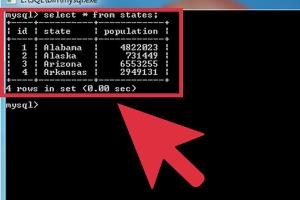Mastering MySQL: A Comprehensive Guide to Creating Databases with Ease

-
Quick Links:
- 1. Introduction to MySQL
- 2. What is a Database?
- 3. Why Use MySQL?
- 4. Setting Up MySQL
- 5. Creating a Database in MySQL
- 6. Database Design Principles
- 7. Real-World Case Studies
- 8. Best Practices for Managing MySQL Databases
- 9. Troubleshooting Common Issues
- 10. FAQs
1. Introduction to MySQL
MySQL is an open-source relational database management system (RDBMS) that uses Structured Query Language (SQL). It is widely used for a variety of applications, from small web projects to large-scale enterprise systems. This guide will walk you through the process of creating a database in MySQL, providing valuable insights and examples along the way.
2. What is a Database?
A database is a structured collection of data that can be easily accessed, managed, and updated. It allows users to store and retrieve information efficiently. In the context of MySQL, databases are designed to handle large volumes of data in a way that is both reliable and scalable.
Types of Databases
- Relational Databases: Data is stored in tables and can be linked through relationships.
- NoSQL Databases: Used for unstructured data, allowing for more flexibility in data storage.
3. Why Use MySQL?
MySQL is favored for its performance, reliability, and ease of use. Here are some compelling reasons to consider using MySQL:
- Open Source: MySQL is free to use and has a large community for support.
- Scalability: Easily scales with your growing data needs.
- Compatibility: Integrates seamlessly with various programming languages.
4. Setting Up MySQL
Before creating a database, you need to install MySQL on your local machine or server. Follow these steps to set up MySQL:
Installation Steps
- Download the MySQL installer from the official website: https://dev.mysql.com/downloads/mysql/
- Run the installer and follow the on-screen instructions.
- Configure MySQL server settings, including root password and port number.
- Start the MySQL service.
5. Creating a Database in MySQL
Once you have MySQL installed and running, you can create your first database. Here’s a step-by-step guide:
Step 1: Access the MySQL Command Line
Open your command line interface (CLI) and log in to MySQL:
mysql -u root -pEnter your password when prompted.
Step 2: Create a New Database
Use the following syntax to create a new database:
CREATE DATABASE database_name;For example:
CREATE DATABASE my_first_database;Step 3: Verify the Database Creation
To ensure your database was created successfully, run:
SHOW DATABASES;Step 4: Use the Database
To start working within your new database, use the command:
USE my_first_database;Step 5: Create Tables
Now that you have a database, you can create tables to store data. Use the following syntax:
CREATE TABLE table_name (
column1_name datatype constraints,
column2_name datatype constraints,
...);
For example:
CREATE TABLE users (
id INT AUTO_INCREMENT PRIMARY KEY,
username VARCHAR(50) NOT NULL,
email VARCHAR(100) NOT NULL,
created_at TIMESTAMP DEFAULT CURRENT_TIMESTAMP
);6. Database Design Principles
Effective database design is crucial for performance and scalability. Here are some key principles:
- Normalization: Organize data to reduce redundancy.
- Indexes: Create indexes to speed up query performance.
- Data Types: Use the appropriate data types for each column to optimize storage.
7. Real-World Case Studies
Let’s explore some real-world applications of MySQL databases:
Case Study 1: E-Commerce Platform
An online retailer uses MySQL to manage product listings, customer data, and order history. By implementing a well-structured database, they achieve faster query responses and a better user experience.
Case Study 2: Content Management System
A blogging platform utilizes MySQL to store user profiles, posts, and comments. The database’s relational structure allows for efficient data retrieval and management.
8. Best Practices for Managing MySQL Databases
To ensure the longevity and efficiency of your MySQL databases, follow these best practices:
- Regularly back up your data.
- Monitor performance and optimize queries.
- Limit user privileges to enhance security.
9. Troubleshooting Common Issues
Encountered an error? Here are some common issues and their solutions:
Common Error: Access Denied
Solution: Ensure you are using the correct username and password.
Common Error: Table Not Found
Solution: Verify the table name and check if it exists in the selected database.
10. FAQs
1. What is MySQL?
MySQL is an open-source relational database management system that uses SQL for data management.
2. How do I create a new database in MySQL?
Use the command CREATE DATABASE database_name; in the MySQL CLI.
3. Can I create multiple databases in MySQL?
Yes, you can create as many databases as your server resources allow.
4. What is normalization?
Normalization is the process of organizing data to minimize redundancy and improve data integrity.
5. How do I back up my MySQL database?
Use the command mysqldump -u username -p database_name > backup.sql.
6. What are the common data types in MySQL?
Common data types include INT, VARCHAR, DATE, and FLOAT.
7. How can I improve the performance of my MySQL database?
Consider indexing, optimizing queries, and regularly monitoring performance metrics.
8. Is MySQL secure?
MySQL can be secure with proper configuration and by limiting user privileges.
9. Can I use MySQL with programming languages?
Yes, MySQL is compatible with various programming languages like PHP, Python, Java, and more.
10. Where can I find more resources on MySQL?
Visit the official MySQL documentation at https://dev.mysql.com/doc/ for more information.
Random Reads
- How to play xbox
- How to run software directly off usb flash drive
- How to filter email in outlook
- How to fill nail holes in trim
- How to make alien sims in the sims 2
- How to open applications with root privileges on a mac
- How to change your picture on yahoo mail
- How to change your nat type on xbox live
- How to persuade parents buy playstation
- Create desktop shortcuts